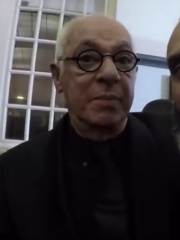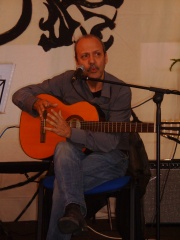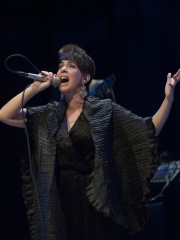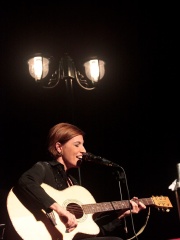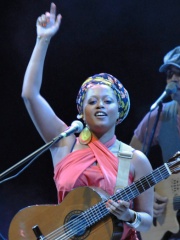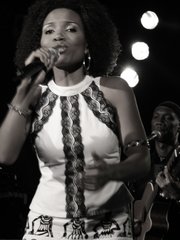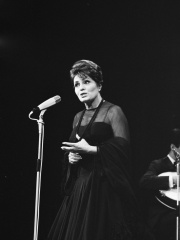
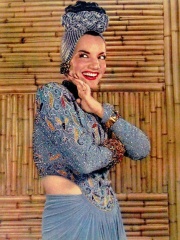
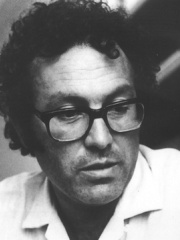
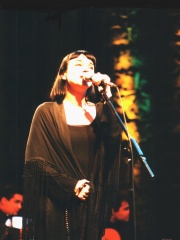
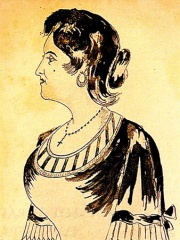



The Most Famous
SINGERS from Portugal
Top 10
The following people are considered by Pantheon to be the top 10 most legendary Portuguese Singers of all time. This list of famous Portuguese Singers is sorted by HPI (Historical Popularity Index), a metric that aggregates information on a biography's online popularity. Visit the rankings page to view the entire list of Portuguese Singers.

1. Amália Rodrigues (1920 - 1999)
With an HPI of 73.65, Amália Rodrigues is the most famous Portuguese Singer. Her biography has been translated into 49 different languages on wikipedia.
Amália da Piedade Rodrigues (23 July 1920 – 6 October 1999) was a Portuguese fado singer (fadista). Dubbed Rainha do Fado ("Queen of Fado"), she was instrumental in popularising fado worldwide and travelled internationally throughout her career. Rodrigues remains the best-selling Portuguese artist in the history of recorded music.

2. Carmen Miranda (1909 - 1955)
With an HPI of 69.74, Carmen Miranda is the 2nd most famous Portuguese Singer. Her biography has been translated into 55 different languages.
Maria do Carmo Miranda da Cunha (9 February 1909 – 5 August 1955), known professionally as Carmen Miranda (Portuguese pronunciation: [ˈkaʁmẽj miˈɾɐ̃dɐ]), was a Brazilian singer, dancer, and actress. Nicknamed "the Brazilian Bombshell," she was known for her signature fruit hat outfits that she wore in her American films. As a young woman, Miranda designed clothes and hats in a boutique before making her debut as a singer, recording with composer Josué de Barros in 1929. Miranda's 1930 recording of "Taí (Pra Você Gostar de Mim)", written by Joubert de Carvalho, catapulted her to stardom in Brazil as the foremost interpreter of samba. During the 1930s, Miranda performed on Brazilian radio and appeared in five Brazilian chanchadas, films celebrating Brazilian music, dance and the country's carnival culture. Hello, Hello Brazil! and Hello, Hello, Carnival! embodied the spirit of these early Miranda films. The 1939 musical Banana da Terra (directed by Ruy Costa) gave the world her "Baiana" image, inspired by Afro-Brazilians from the north-eastern state of Bahia. In 1939, Broadway producer Lee Shubert, after seeing Miranda perform at Cassino da Urca in Rio de Janeiro, offered her an eight-week contract to perform in The Streets of Paris. The following year she made her first Hollywood film, Down Argentine Way, co-starring Don Ameche and Betty Grable, and her exotic clothing and Brazilian Portuguese accent became her trademark. That year, she was voted the third-most-popular personality in the United States; she and her group, Bando da Lua, were invited to sing and dance for President Franklin D. Roosevelt. In 1941, she was the first Latin American star to be invited to leave her handprints and footprints in the courtyard of Grauman's Chinese Theatre and was the first South American honored with a star on the Hollywood Walk of Fame. In 1943, Miranda starred in Busby Berkeley's The Gang's All Here, which featured musical numbers with the fruit hats that became her trademark. By 1945, she was the highest-paid woman in the United States. Miranda made 14 Hollywood films between 1940 and 1953. Although she was hailed as a talented performer, her popularity waned by the end of World War II. Miranda came to resent the stereotypical "Brazilian Bombshell" image she had cultivated and attempted to free herself of it with limited success. She focused on nightclub appearances and became a fixture on television variety shows. Despite being stereotyped, Miranda's performances popularized Brazilian music and increased American awareness of Latin culture. Miranda is considered the precursor of Brazil's 1960s Tropicalismo cultural movement. A museum was built in Rio de Janeiro in her honor and she was the subject of the documentary Carmen Miranda: Bananas Is My Business (1995).

3. Zeca Afonso (1929 - 1987)
With an HPI of 61.70, Zeca Afonso is the 3rd most famous Portuguese Singer. His biography has been translated into 26 different languages.
José Manuel Cerqueira Afonso dos Santos (2 August 1929 – 23 February 1987), known professionally as José Afonso and also popularly known as Zeca Afonso, was a Portuguese singer-songwriter. He is widely regarded as one of the most influential figures in the history of Portugal's folk and protest music scene. His music played a significant role in the resistance against the dictatorial Estado Novo regime, making him an icon in Portugal. Afonso's song "Grândola, Vila Morena" was used as a radio-broadcast signal by the Armed Forces Movement during their military coup operation in the morning of 25 April 1974, which led to the Carnation Revolution and the transition to democracy in Portugal. Subsequently, Afonso's music, along with "Grândola, Vila Morena," became emblematic of the revolution, anti-fascism, the Portuguese labor movement, and the political left.

4. Mísia (1955 - 2024)
With an HPI of 61.45, Mísia is the 4th most famous Portuguese Singer. Her biography has been translated into 24 different languages.
Susana Maria Alfonso de Aguiar (18 June 1955 – 27 July 2024), known mononymously as Mísia, was a Portuguese fado singer. She was a polyglot, singing some of her songs in Spanish, French, Catalan, English, and Japanese.
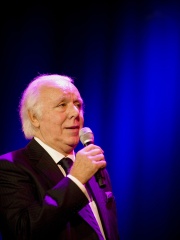
5. Carlos do Carmo (1939 - 2021)
With an HPI of 61.32, Carlos do Carmo is the 5th most famous Portuguese Singer. His biography has been translated into 27 different languages.
Carlos Manuel de Ascenção do Carmo de Almeida (21 December 1939 – 1 January 2021), better known as Carlos do Carmo, was a Portuguese fado singer. The son of Lucília do Carmo, a well-known fadista, do Carmo began his career in fado following his father's death in 1962, when he returned from a period in Switzerland to help his mother run the family's fado house. He began singing himself shortly afterwards and, in 1963, he began his career as a recording artist. He continued working at the fado house for a number of years, while also expanding his recording career. He achieved national and international success in the 1970s, including performances at the Royal Opera House in London and the Paris Olympia. He represented Portugal at the 1976 Eurovision Song Contest with his song "Uma flor de verde pinho", finishing in 12th place. Carmo introduced new styles to fado, including the addition of orchestras, and the incorporation of other styles such as jazz into the traditional music.

6. Maria Severa Onofriana (1820 - 1846)
With an HPI of 59.99, Maria Severa Onofriana is the 6th most famous Portuguese Singer. Her biography has been translated into 19 different languages.
Maria Severa Onofriana (26 July 1820 – 30 November 1846), also known simply as A Severa, was a Portuguese fado singer and guitarist. She is regarded, in her short life, as the first fado singer to have risen to fame, attaining a near-mythical status after her death. Fado has been described as the Portuguese expression of "the blues", and fado roughly means 'fate'.

7. Dulce Pontes (b. 1969)
With an HPI of 58.22, Dulce Pontes is the 7th most famous Portuguese Singer. Her biography has been translated into 33 different languages.
Dulce José Silva Pontes (Portuguese: [ˈdulsɨ ʒuˈzɛ ˈsilvɐ ˈpõtɨʃ]; born 8 April 1969) is a Portuguese songwriter and singer who performs in many musical styles, including pop, folk, and classical music. She is usually defined as a world music artist. Her songs contributed to the 1990s revival of Portuguese urban folk music called fado.

8. Salvador Sobral (b. 1989)
With an HPI of 57.66, Salvador Sobral is the 8th most famous Portuguese Singer. His biography has been translated into 61 different languages.
Salvador Vilar Braamcamp Sobral (European Portuguese: [salvɐˈðoɾ viˈlaɾ βɾɐ̃ˈkɐ̃p suˈβɾal]; born 28 December 1989) is a Portuguese singer, who won the Eurovision Song Contest 2017 for Portugal with the song "Amar pelos dois", written and composed by his sister, Luísa Sobral. In doing so, he gave Portugal its first ever win in the contest since its debut in 1964, ending the longest winless run by a country in Eurovision history (53 years). Sobral and his entry hold the Eurovision record for the highest-scoring winner as of 2017, having earned a total of 758 points under the current voting system, after winning both the jury vote and televote.

9. Simone de Oliveira (b. 1938)
With an HPI of 56.29, Simone de Oliveira is the 9th most famous Portuguese Singer. Her biography has been translated into 20 different languages.
Simone de Macedo e Oliveira (born 11 February 1938), better known as Simone de Oliveira, is a Portuguese singer and actress. She represented Portugal at the 1965 and 1969 editions of the Eurovision Song Contest, with the songs "Sol de inverno" and "Desfolhada portuguesa" respectively.
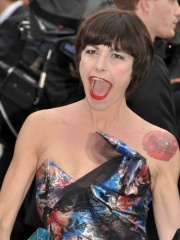
10. Lio (b. 1962)
With an HPI of 55.11, Lio is the 10th most famous Portuguese Singer. Her biography has been translated into 21 different languages.
Vanda Maria Ribeiro Furtado Tavares de Vasconcelos (born 17 June 1962), known professionally as Lio, is a Portuguese-Belgian singer and actress who was a pop icon in France and Belgium during the 1980s. In 2024 she began serving as a judge on Drag Race Belgium.
People
Pantheon has 34 people classified as Portuguese singers born between 1820 and 1994. Of these 34, 27 (79.41%) of them are still alive today. The most famous living Portuguese singers include Dulce Pontes, Salvador Sobral, and Simone de Oliveira. The most famous deceased Portuguese singers include Amália Rodrigues, Carmen Miranda, and Zeca Afonso. As of April 2024, 2 new Portuguese singers have been added to Pantheon including Lura, and Iolanda.
Living Portuguese Singers
Go to all RankingsDulce Pontes
1969 - Present
HPI: 58.22
Salvador Sobral
1989 - Present
HPI: 57.66
Simone de Oliveira
1938 - Present
HPI: 56.29
Lio
1962 - Present
HPI: 55.11
Paulo de Carvalho
1947 - Present
HPI: 53.66
Carlos Mendes
1947 - Present
HPI: 53.53
Tonicha
1946 - Present
HPI: 52.55
Teresa Salgueiro
1969 - Present
HPI: 52.22
Lúcia Moniz
1976 - Present
HPI: 49.47
Ana Moura
1979 - Present
HPI: 49.37
Suzy
1980 - Present
HPI: 48.54
Adelaide Ferreira
1959 - Present
HPI: 48.13
Deceased Portuguese Singers
Go to all RankingsAmália Rodrigues
1920 - 1999
HPI: 73.65
Carmen Miranda
1909 - 1955
HPI: 69.74
Zeca Afonso
1929 - 1987
HPI: 61.70
Mísia
1955 - 2024
HPI: 61.45
Carlos do Carmo
1939 - 2021
HPI: 61.32
Maria Severa Onofriana
1820 - 1846
HPI: 59.99
Sara Tavares
1978 - 2023
HPI: 48.00
Newly Added Portuguese Singers (2025)
Go to all RankingsOverlapping Lives
Which Singers were alive at the same time? This visualization shows the lifespans of the 7 most globally memorable Singers since 1700.

